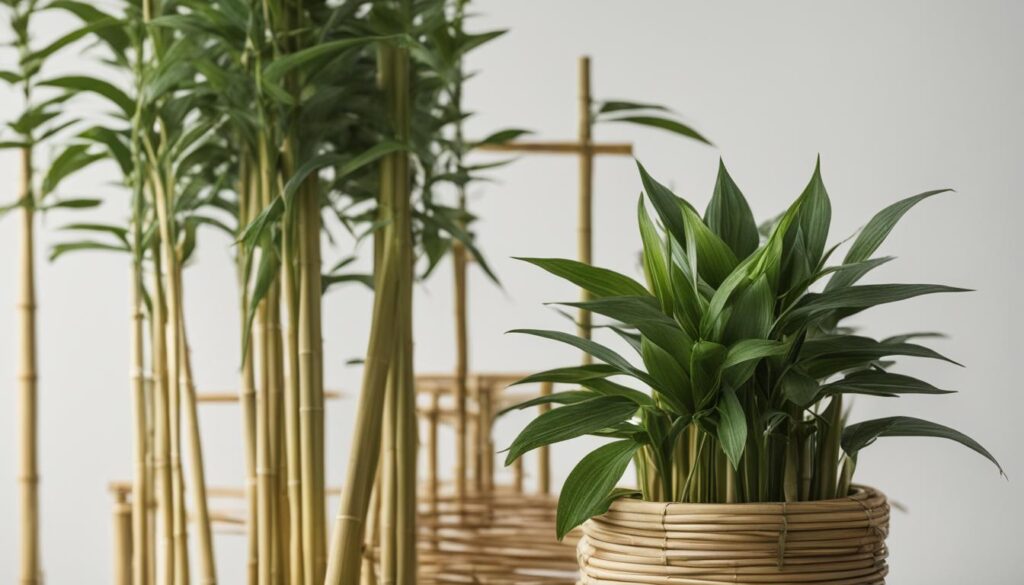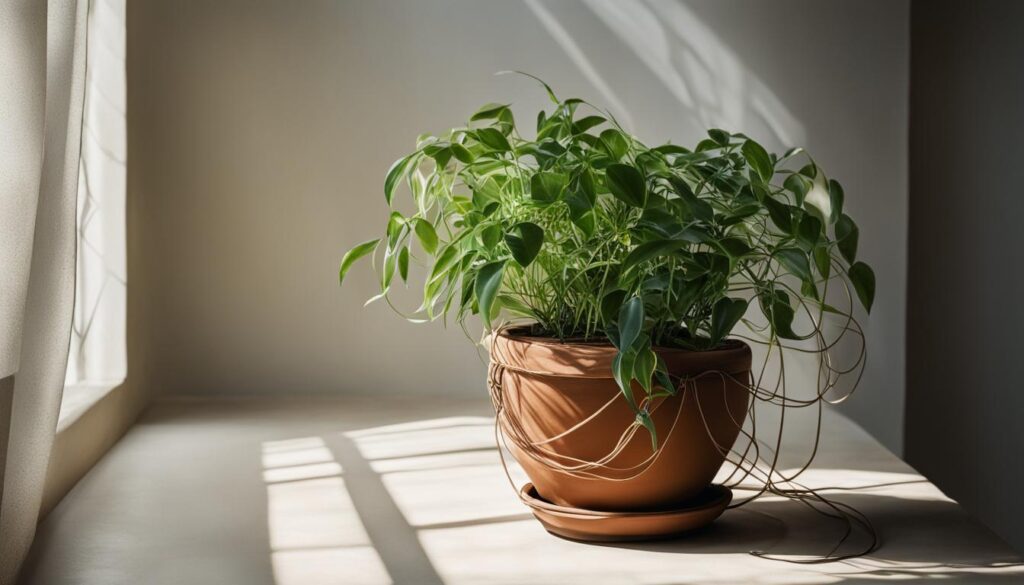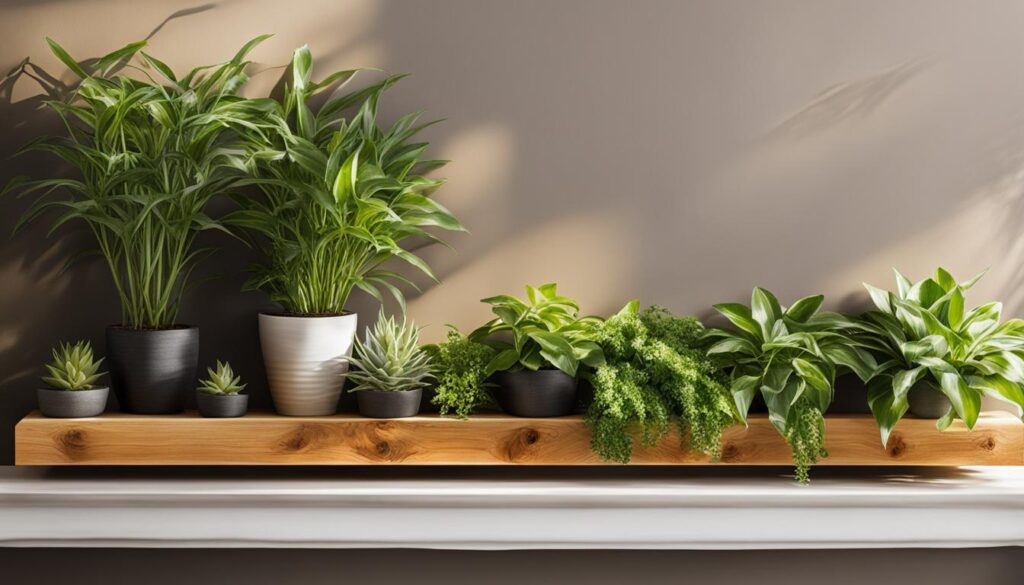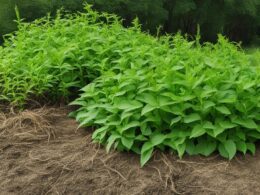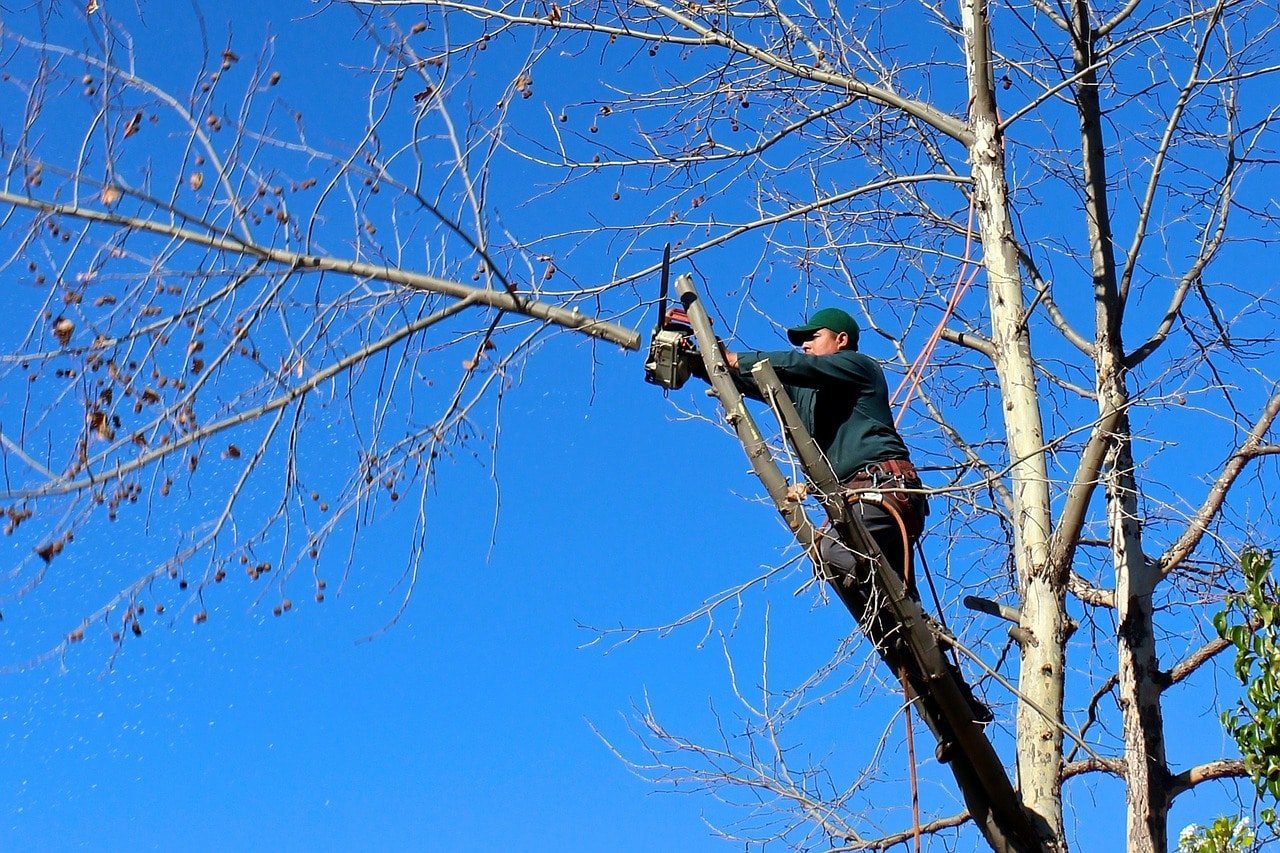Staking indoor houseplants can help support their growth and prevent weak stems. Some plants naturally require staking, while others may need support as they climb or grow larger. There are various methods of plant support, including using stakes, wire support, moss poles, bamboo teepees, wood planks, trellises, cages, walls, hooks, and nails.
Post Summary
- Staking indoor plants provides support and prevents weak stems.
- Methods of plant support include stakes, wire support, moss poles, bamboo teepees, wood planks, trellises, cages, walls, hooks, and nails.
- Choose the appropriate plant support method based on the type of plant and its growth habits.
- Properly supporting indoor plants ensures healthy growth and adds beauty to your home garden.
- Consider the aesthetics and functionality of different plant support ideas to enhance your indoor plant displays.
Using Stakes for Support
Staking plants with straight stakes is a popular method for providing support to single-stemmed plants or those that have become top-heavy. This technique is especially useful for indoor houseplants that may need a little extra assistance in maintaining an upright position. To stake a plant, simply drive a stake deep into the soil next to the plant, making sure it reaches the bottom of the pot. It’s important to use commercial stakes made of sturdy materials such as bamboo or vinyl-coated metal to ensure durability and longevity.
When securing the plant to the stake, it’s best to use stretchy and flexible ties such as nylon or special plant ties. These ties allow for gentle but secure attachment without causing damage to the plant. Be careful not to tie the plant too tightly, as this can restrict its growth and cause harm. As the plant continues to grow, periodically check the ties and adjust them accordingly to accommodate the plant’s development.
Staking plants with straight stakes provides stability and support, allowing them to grow taller and stronger. It not only helps prevent weak stems but also promotes proper air circulation and light exposure, which are crucial for optimal plant health. By utilizing this method of plant support, you can ensure that your indoor houseplants thrive and maintain their desired form.
Using Wire Support
Wire support is a versatile method that can be used to shape and provide stability for your indoor plants. Whether you have long branches that need extra support or want to train your plants to grow in a specific shape, wire support can help you achieve your goals. Here are some tips on how to effectively use wire support for your plants.
Benefits of Wire Support
Using wire support for your plants offers several benefits. It helps prevent your plants from sagging or bending under their own weight, ensuring that they grow strong and healthy. Wire support also allows you to create unique shapes or patterns with your plants, adding visual interest to your indoor garden. Additionally, wire support enables climbing plants to attach and grow, providing them with the necessary structure for upward growth.
Creating a Wire Trellis
To create a wire trellis, you will need a fence or wall to attach it to. Fix flat wires spaced 45cm apart on the fence, ensuring they are securely attached. Run a thicker wire through these flat wires to create the primary support structure. Secure the wire ends by looping through the eye and folding over the shank. This creates a stable trellis that your plants can grow and climb on. As your plants grow, gently tie them to the wire support to guide their growth and create a hoop-shaped appearance.
| Benefits of Wire Support | Creating a Wire Trellis |
|---|---|
| Prevents sagging and bending | Fix flat wires on a fence or wall |
| Enables unique shapes and patterns | Run a thicker wire through the flat wires |
| Provides support for climbing plants | Secure wire ends by looping through the eye |
Wire Support Tips
- Choose sturdy and durable wires to ensure they provide adequate support.
- Secure the wires tightly to prevent them from loosening or falling off.
- Regularly check the wire support for any signs of damage or wear and replace if necessary.
- Adjust the wire support as your plants grow to accommodate their changing size and shape.
Using Moss Poles
When it comes to providing support for climbing plants, moss poles are an excellent option. These poles are specifically designed to help climbers grip and thrive, ensuring healthy growth and stunning displays. Moss poles are made by filling a narrow wire tube with damp sphagnum moss, creating a supportive structure for the plant.
To use a moss pole for plant support, simply tie the plant to the pole using plant ties or stretchy nylon. As the plant grows, it will naturally latch onto the moss pole, allowing it to climb and develop a beautiful, hoop-shaped appearance. The damp moss provides extra moisture for the plant, encouraging attachment and growth.
If you’re not up for making your own moss pole, you can easily find premade ones at your local garden center or specialty craft store. These moss poles are specifically designed for climbing plants and provide the perfect amount of support and moisture to keep your plants thriving.
Benefits of Using Moss Poles for Plant Support
- Encourages healthy growth and prevents weak stems
- Provides a natural and aesthetically pleasing support structure
- Offers additional moisture for the plant to attach and thrive
- Great option for climbers that require support to grip
Overall, moss poles are a fantastic choice for providing support to climbing plants. Whether you make your own or purchase a premade one, a moss pole will help your plants thrive and add a touch of elegance to your indoor garden.
| Benefits of Moss Poles | Methods of Plant Support |
|---|---|
| Encourages healthy growth and prevents weak stems | Stakes |
| Provides a natural and aesthetically pleasing support structure | Wire Support |
| Offers additional moisture for the plant to attach and thrive | Moss Poles |
| Great option for climbers that require support to grip | Bamboo Teepees |
Using Bamboo Teepees
When it comes to supporting your indoor plants, bamboo teepees are a practical and attractive option. These conical trellises are perfect for guiding the growth of climbing plants or providing support for delicate vines. The natural aesthetic of bamboo blends seamlessly with your indoor greenery, creating a visually appealing addition to your home.
Creating a bamboo teepee is simple. Start by arranging bamboo sticks or any flexible material, such as willow branches, in a conical shape. Use twine or plant ties to secure the sticks together at the top, forming a sturdy structure. Place the teepee in the pot, ensuring it is firmly anchored in the soil. As your plants grow, gently guide their vines around the teepee, allowing them to climb and find support.
“Bamboo teepees are a practical and attractive option for supporting indoor plants.”
Bamboo teepees offer several advantages when it comes to plant support. Firstly, they provide stability for climbing plants, allowing them to grow vertically and reach their full potential. Secondly, the teepee shape creates multiple surfaces for vines to grip onto, aiding their natural growth pattern. Finally, the natural materials used in bamboo teepees are eco-friendly and add a touch of natural beauty to your indoor garden.
| Advantages of Using Bamboo Teepees | Disadvantages of Using Bamboo Teepees |
|---|---|
|
|
Overall, bamboo teepees are a versatile and effective option for supporting indoor plants. Whether you have a climbing vine or a delicate trailing plant, a teepee trellis can provide the necessary structure and support for healthy growth. Consider incorporating bamboo teepees into your indoor gardening routine to enhance the beauty and health of your plants.
For a visually engaging presentation, here is a table summarizing the benefits and considerations of using wood planks as plant support:
| Benefits | Considerations |
|---|---|
|
|
Using wood planks as plant support can be an effective way to ensure the health and growth of your indoor plants. By providing a sturdy anchor for vines and climbing plants, you can create a beautiful and thriving indoor garden.
Using Trellises
When it comes to providing support for bushy houseplants, trellises are a fantastic option. Trellises come in various shapes and materials, including bamboo, wood, metal, wire, and plastic. They not only offer structural support but also add a decorative element to your indoor garden. Trellises are particularly suitable for plants with sprawling growth habits that require assistance in staying upright.
Installing a trellis in the pot at the same time you plant the vine ensures that the plant has a sturdy structure to grow on from the beginning. You can find pre-made trellises or get creative and make your own using twigs and branches. This allows you to customize the trellis to fit the aesthetic you desire for your indoor garden.
One of the advantages of trellises is that they provide vertical support, allowing plants to grow upward and save space. This is especially beneficial for those with limited space or for those who want to create a visually pleasing display. The trellis acts as a framework for the plant to climb, ensuring that it grows in an organized and controlled manner.
Using a trellis for your bushy plants not only helps them maintain their shape but also promotes healthy growth by allowing better air circulation and light exposure. It prevents the plant from becoming tangled and overcrowded, reducing the risk of diseases and pests. Additionally, trellises make it easier to inspect your plants and provide proper care, such as watering and pruning.
Using Cages
When it comes to supporting top-heavy plants, using cages is an excellent option. Whether you have multi-stemmed plants with blooming flowers or dense foliage, cages provide the necessary support to prevent the plants from toppling over. A single wire cage or a system of multiple stakes with twine can be used to create a sturdy cage support system.
Unlike other support methods, cages eliminate the need to tie the plant directly to the support structure. The cage itself acts as a protective barrier, cradling the plant and providing stability. It is important to make sure that the cage is large enough to accommodate the plant’s growth, allowing ample space for the branches to spread out.
Using a cage support system also offers practical advantages. It simplifies maintenance as the plant can grow freely within the cage, without the need for constant adjustment or retying. Additionally, cages can be easily customized to fit the size and shape of your plants, ensuring a tailored solution for each individual need.
Comparison of Different Cage Sizes for Top-Heavy Plants
| Cage Size | Plant Type | Benefits |
|---|---|---|
| Narrow Cage | Rose bushes | Provides support for heavy blooms and prevents the plant from leaning |
| Medium Cage | Tomato plants | Supports the weight of the fruit-laden vines, ensuring upright growth |
| Large Cage | Pepper plants | Prevents sprawling and keeps the plants compact, maximizing space |
By using cages as a plant support system, you can maintain the health and aesthetics of your top-heavy plants. The cage’s structure provides the necessary reinforcement, allowing the plants to thrive without the risk of toppling over. With the flexibility to customize cage size based on the plant’s needs, you can create a tailored support solution that helps your plants reach their full potential.
Conclusion
Properly supporting your indoor plants is crucial for their healthy growth and to prevent weak stems. In this article, we have explored various effective methods of plant support that you can implement in your home garden.
Whether it’s staking single-stemmed plants, using wire support for long branches, or utilizing moss poles for climbers, there are plenty of options to choose from. Bamboo teepees and wood planks provide additional support and are great for plants in limited space.
Trellises and cages are ideal for bushier and top-heavy plants, offering stability and room for growth. By selecting the right support method based on the needs of your plants, you can ensure their well-being and enhance the beauty of your indoor garden.
Remember, proper support will help your plants thrive. So give them the support they need and watch them flourish in your home!
How Can Indoor Plant Support Ideas Help Maintain Healthy Indoor Air Quality?
Incorporating indoor plants into your home can provide natural indoor plants air toxins cleansing, helping to maintain healthy indoor air quality. By choosing the right plants and implementing creative indoor plant support ideas, you can effectively reduce air pollutants and improve the overall air quality in your indoor spaces.
FAQ
Why do indoor houseplants need support?
Staking indoor houseplants can help support their growth and prevent weak stems.
Which plants require staking?
Some plants naturally require staking, while others may need support as they climb or grow larger.
What are some methods of plant support?
There are various methods of plant support, including using stakes, wire support, moss poles, bamboo teepees, wood planks, trellises, cages, walls, hooks, and nails.
How do I stake a plant using straight stakes?
To stake a plant, drive a stake deep into the soil next to the plant, ensuring it reaches the bottom of the pot. Secure the plant to the stake with stretchy ties like nylon or special plant ties, being careful not to tie it too tight.
How can I use wire support for plants?
Fix flat wires spaced 45cm apart on a fence and run wire through them to create a trellis. You can also use moss poles made from wire filled with damp sphagnum moss for climbing plants like jasmine.
What are moss poles and how do I use them for plant support?
Moss poles are wire tubes filled with damp sphagnum moss. You can create a moss pole by filling a narrow wire tube with damp sphagnum moss and tying the plant to the pole until it latches on by itself.
How do I use bamboo teepees for plant support?
Construct a teepee by arranging bamboo sticks or any flexible material in a conical shape and securing them with twine. Place the teepee in the pot and guide the plants’ growth around it.
How can wood planks provide support for plants?
Placing a rough wood plank at the bottom of the container allows the plants’ roots to hold onto it and attach themselves. Tie the vines to the wooden plank using stretch tie tape or plant ribbon.
How can I use trellises for plant support?
Trellises provide a sturdy structure for plants to grow and can be shaped to fit the desired aesthetic. Install the trellis in the pot at the same time you plant the vine.
How do I use cages for plant support?
Cages are ideal for multi-stemmed plants that are top-heavy with blooms or foliage and cannot support themselves. You can use a single wire cage or multiple stakes with twine to form a support system.






